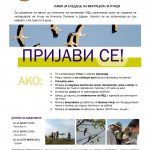Третиот по ред Цензус на пеликани се одржа на 16 мај 2015 година, на водни површини на 41 локација долж цела Грција. Целта на цензусот беше да се евидентира вкупниот број на пеликани кои ги користат водните површини во земјата за време на периодот на разможување.
Цензусот е иницијатива на Друштвото за заштита на Преспа (СПП) и Грчкото Орнитолошко Друштво и беше успешно спроведен благодарение на управувачките тела на 12 заштитени подрачја. Цензусот на Преспанското Езеро кое го делат трите држави, беше спроведено на прекугранично ниво од страна на СПП во соработка со Албанското орнитолошко друштво и Македонското еколошко друштво.
Цензусот ги опфаќа двата вида пеликани кои се среќаваат на Преспанско: загрозениот кадрав пеликан (Pelecanus crispus) и големиот бел пеликан (Pelecanus onocrotalus).
Оваа година цензусот беше одржан подоцна во споредба со претходните две години, сè со цел да се добие поточна бројка за сите пеликани кои ја завршиле миграцијата од Источна Африка до Југоисточна Европа во мај.
Вкупно 4000 кадрави пеликани беа изброени во 24 водни живеалишта и 1000 единки на големите бели пеликани во 11 водни површини во земјата. Популацијата на кадравиот пеликан е помалку или повеќе стабилна во последниве три години, додека пак значително поголем број единки од обичниот пеликан беа забележани оваа година. Овој пораст се должи на одлуката оваа година подоцна да се одржи цензусот. Иако глобално многу ретки, кадравиот пеликан има основано 5 колонии во Грција, од кои најголемата на Малото Преспанско Езеро, која воедно е и најголема во светот. Големиот бел пеликан е интернационално поброен и има поголема дистрибуција, а во Грција е на најзападната точка од неговото распространување. До оваа година единствената колонија на големиот бел пеликан во Грција беше на Малото Преспанско Езеро. Сепак, на овогодинешниот цензус истражувачите потврдија дека големиот бел пеликан, исто така се размножува на басенот на поранешното езеро Карла во Тесалија, на истото островче како и постоечката колонија на кадравиот пеликан. Иста така, важно е да се напомене дека басенот на Карла привлекува голем број ретки и заштитени птици, факт што укажува на огромното еколошко значење на процесот на рестарвација кој се одвиваше во последните 10 години.
Водните живеалишта каде што пеликаните се размножуваат – Мала Преспа, Бутковско Езеро, Мисолонги и Езерото Карла – играат клучна улога во заштитата и сочувувањето на двата видови. Сепак, значителен број на пеликани беа забележани на многу други водни површини, бидејќи тие ги обезбедуваат потрбите за храна за време на периодот на размножување, обезбедуваат безбедни и мирни места за несење и исто така претставуваат добри места за одмор за време на миграцијата.
Податоците добиени од цензусот придонесуваат кон креирањето на мерките за заштита и зачувување на пеликаните и исто така, ја истакнуваат потребата за интегрирана заштита и управување со водните живеалишта како целина. Тие исто така ја посочуваат и важноста на соработката помеѓу различните организации и индивидуи, бидејќи би било невозможно активности од толкави размери да се извршат без ваков вид на соработка.
Резултатите од трите цензуси, како и кратка анализа на податоците беа презентирани на вториот работен состанок за пеликаните, кој беше одржан во Бутково на 25 и 26 јуни, каде учество земаа Грчкото орнитолошко друштво, СПП и други девет управувачки тела.The 3rd Pan-Hellenic Pelican Census was carried out for the third year in succession, on 16th May 2015, in 41 wetlands throughout Greece. The aim of the census was to record the total number of pelicans that use the wetlands of the country during their breeding period.
The census is an initiative of the Society for the Protection of Prespa (SPP) and the Hellenic Ornithological Society and it was successfully achieved thanks to the participation of the Management Bodies for 12 protected areas – Evros Delta; Nestos Delta-Vistonida-Ismarida; Koroneia & Volvi Lakes; Lake Kerkini; Axios Delta-Loudias-Aliakmonas; Prespa National Park; Pamvotida Lake; Karla-Mavrovounio-Kefalovryso-Velestino; Amvrakikos Wetlands; Messolonghi Lagoon; Straits and Estuaries of the Acherondas and Kalamas Rivers; Kotychio-Strophylia Wetlands – and several volunteers from the Hellenic Ornithological Society network. The census of the Prespa Lakes, which is shared by three countries, was carried out at transboundary level by the SPP in co-operation with Albanian ornithologists and the environmental organisation MES (Republic of Macedonia).
The census counts the two species of pelican that are found in Greece: the globally endangered Dalmatian pelican (Pelecanus crispus) and the Great white pelican (Pelecanus onocrotalus). This year the activity was held later than in previous years, in order to more accurately count the numbers of great white pelicans, as they fully complete their migratory journey from eastern sub-Saharan Africa to the countries of SE Europe in May.
In total almost 4000 Dalmatian pelicans in 24 wetlands and 1000 Great white pelicans in 11 wetlands were recorded. The number of Dalmatian pelicans has remained more or less stable over the three years of the census, whereas significantly larger numbers of Great white pelicans were recorded this year. This increase is directly related to the decision to hold this year’s census at a later date, as noted above. Although globally very rare, the Dalmatian pelican has established five colonies in Greece, with the largest of these at Lesser Prespa Lake, which is also the largest in the world. The Great white pelican is internationally more numerous and has a wider distribution, and in Greece it is at the western-most edge of its range. Until this year, the only Great white pelican colony in Greece was at Lesser Prespa Lake. However, on a later date of this year’s census researchers confirmed that great white pelicans also bred at the reservoir of the former Lake Karla in Thessaly, on the same islet as an existing Dalmatian pelican colony. It is also worth noting here that the Karla Reservoir attracts increasing numbers of rare and protected bird species, a fact which demonstrates the enormous ecological importance of the restoration works which have been carried out there in the last 10 years.
The wetlands where the pelicans breed – Lesser Prespa, Kerkini, Amvrakikos, Messolonghi and Karla – play a crucial role in the protection and conservation of the two species. As expected, the largest numbers of pelicans were recorded in these wetlands. However, significant numbers of pelicans were recorded at many other wetlands, as these cover the birds’ needs for food during the breeding period, provide safe and undisturbed roosting areas and are also used as stop-overs during migration.
The data collected during the census contribute to the design of protection and conservation measures for the country’s pelicans and also highlight the need for the integrated protection and management of Greek wetlands as a whole. They also demonstrate the importance of collaboration between different organisations and individuals, as it would be impossible to carry out such a large-scale activity without this kind of co-operation.
The results of the three censuses, as well as a brief analysis of the data, were presented at the 2nd Working Meeting for Pelicans, which was held in Kerkini on 25th-26th June, and in which the Hellenic Ornithological Society, the SPP and 9 management bodies participated.
For more information:
Dimitra Paschalidou, Communications Officer, Society for the Protection of Prespa, 0030 23850 51211
Roula Trigou, Conservation Activities Communications Co-ordinator, Hellenic Ornithological Society, 0030 210 8228704
Photo 1 (Left): During the 3rd Pan-Hellenic Pelican Census | Ó ARCHIVE of the Management Body for the Straits and Estuaries of the Acherondas and Kalamas Rivers
Photo 2 (Right): At the 2nd Working Meeting for Pelicans, 25th-26th June, Kerkini | Ó Rea Papadopoulou / HELLENIC ORNITHOLOGICAL SOCIETY Archive


